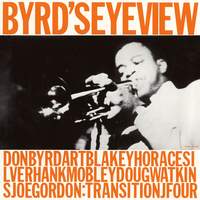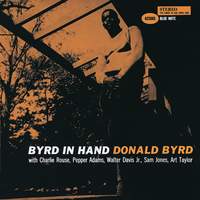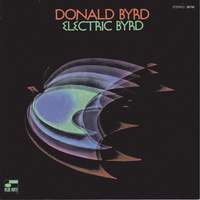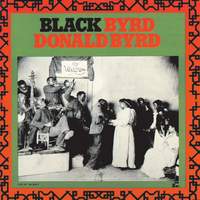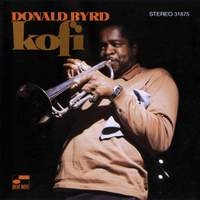Classic Recordings,
The Music of Donald Byrd

One of the finest trumpeters of his time, Donald Byrd worked prolifically as both a sideman and bandleader, establishing himself as an expressive player who was as fierce as he was tuneful. Byrd broke onto the bebop scene in New York in his early twenties, and was quickly picked up by Art Blakey and the Jazz Messengers as the successor to Clifford Brown - big shoes to fill, indeed. He would go on to play with the Jazz Messengers until 1956 before leaving to focus on a solo career - spending time hopping around the backing bands of John Coltrane, Sonny Rollins and Thelonious Monk. There was still some crossover, with a handful of Jazz Messengers appearing on some of Byrd’s first solo recordings.
From the early ‘60s throughout most of his career, Byrd worked closely with the baritone saxophonist Pepper Adams, who appears on many of Byrd’s recordings as a sideman, as well as a young Herbie Hancock. Byrd was a fervent supporter of young musicians, often tutoring them on the less romantic side of the music business - contract negotiations and the like - and it was Byrd who encouraged Hancock not to hand his publishing rights over to Blue Note for his debut album. Blue Note would eventually relent, which saw Hancock receiving tidy royalty cheques for his work - the famed keyboardist and jazz-funk pioneer cites it as some of the best advice he’s ever received. It was Byrd’s 1962 record Royal Flush that Hancock featured on as his first Blue Note session, too, exposing the then-budding pianist to new ears, and as a further gesture of goodwill, Byrd even let Hancock stay in his flat for many years whilst mentoring this emerging talent.
Byrd would record constantly throughout his lifetime - especially with Blue Note - starting from the late ‘50s to early ‘70s, sometimes with his ex-Jazz Messengers bandmates, even experimenting with jazz fusion briefly in the 1970s, taking inspiration from Miles Davis’ experiments in the genre, later transitioning into jazz-funk, soul and even disco-influenced music. Byrd’s legacy goes beyond the jazz tradition, too; as one of the most-sampled jazz artists, you can also hear his licks on tracks by hip-hop artists Nas, A Tribe Called Quest and 2Pac, just to name a few. One of the more quietly influential figures of mid-twentieth-century American jazz, we’ve recommended some of our favourite releases below as a means of getting started with his vast catalogue.
Byrd's Eye View (1956)
One of the earliest albums released with ‘Donald Byrd’ on the cover, upon closer inspection Byrd’s Eye View is a Jazz Messengers record in all but name - not that that’s a bad thing, of course. That being said, it’s Byrd that leads the set, and at only 23 years old at the time you can hear why Blakey and co. snapped him up when they had the chance. Besides Blakey, the Byrd’s Eye View sessions also features the mid-’50s Jazz Messengers lineup of fellow trumpeter Joe Gordon, Hank Mobley on sax, Horace Silver on piano, and Doug Watkins on bass, with Watkins and Mobley contributing their own pieces to the tracklist. Byrd’s Eye View didn’t make the biggest of splashes upon release, but set a great precedent for the beginning of the trumpeter’s long recording career.
Byrd In Hand (1959)
Byrd In Hand comes across as a somewhat straightforward affair for Byrd and company, and the record didn’t make much of an impression on the jazz press at the time - the Penguin Guide to Jazz even passive-aggressively calls it a “typical Blue Note blowing session” - but the session sees Byrd’s rapidly developing sound coming together. The set itself features an excellent roster of players including Walter Davis Jr., Sam Jones and Art Taylor, and includes two of Davis’s own tunes as well as a handful of Byrd tunes, though sadly none of these tunes would catch on.
At the Half Note Cafe (1960)
This two-hour set from the Byrd and Pepper Adams quintet was originally issued by Blue Note as a two-part record and has since been reissued as a complete album. The band on At the Half Note Cafe was composed of players Byrd had mentored, including the pianist Duke Pearson, who would later go on to work prolifically as both a session musician and music producer. It’s Pearson in particular who shines in this ensemble, with Byrd hanging back perhaps to give his young student some time in the spotlight, and the pianist contributes four of his own works to the proceedings alongside Byrd’s five, making for a hefty two-hour set with both editions combined.

Electric Byrd (1970)
Taking cues in particular from Miles Davis’s Bitches Brew released that same year, though Byrd’s take on the fusion style is a little more accessible than Davis’s more extreme angle. Byrd works again with his same stable of musicians - folks like bassist Ron Carter and saxophonist Pepper Adams - but also guitarist Wally Richardson, as well as Duke Pearson on electric piano, the second time Byrd had used this instrument in his works after Fancy Free, released earlier that year. Similar experiments in fusion were also made on 1971’s Ethiopian Nights, with Byrd focussing on extended jams and funkier rhythms.
Black Byrd (1973)
Available Formats: MP3, FLAC, Hi-Res FLAC, Hi-Res+ FLAC
Following on from Electric Byrd and Ethiopian Nights, 1973’s Black Byrd is one of the funkiest entries in his discography - and of the Blue Note catalogue, for that matter. Similarly to his take on fusion on Electric Byrd, Black Byrd keeps to comparatively agreeable sounds when put side-by-side with his contemporaries. Nonetheless, Byrd’s ear for simple and tuneful melodies shines through against the laid-back grooves. Black Byrd also marked the first Blue Note recording to be produced by the Mizell Brothers, Alphonso Mizell being an ex-Motown producer, a production pair who would later define the sound of jazz-funk, acid jazz and neo soul.
Kofi (1995)
Another gem of the Byrd discography is Kofi, recorded during his same tenure for Blue Note in the ‘70s but not released until 1995. Even so, Kofi stands out as one of Byrd’s strongest releases, an exemplary piece of laid-back traditional bebop, recorded shortly before his foray into jazz-funk and fusion. Lew Tabackin’s dancing flute lines on the title track make for a sublime icing on top of an already great tune, and the set in general is one of the trumpeter’s more relaxed works. One of the more relaxed entries in his catalogue but a strong one nonetheless, it’s a real wonder why this record sat in the vaults as long as it did.


